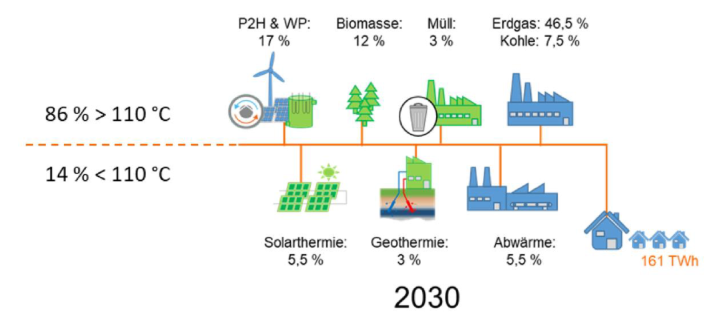For the heat supply of the future to become climate-neutral, the expansion of district heating networks, especially in urban areas, is key. The Ariadne Scenario Report calculates that this would require the connection of 160,000 households per year – but so far just half as many are actually connected to the district heating network. Ariadne researchers from the Institute of Energy Economics and the Rational Use of Energy (IER) at the University of Stuttgart analyzed the current challenges to district heating expansion: In addition to the already challenging defossilization of heat generation, there is now the early coal phase-out and the current gas crisis. In the latest Ariadne analysis “Change in District Heating in the Context of the Coal Phase-out and the Current Gas Crisis”, the researchers show how, against this background, the obstacles to the expansion of district heating can be removed.
For the defossilization of the district heating supply, the share of renewable energies must increase from the current 11 percent to 100 percent by 2045. The greatest challenge here is the rapid replacement of coal as an energy source, since an early phase-out of coal-fired power plants is already planned by 2030. The use of gas was planned as an interim solution – but due to the Ukraine war and the halt in gas deliveries from Russia, this option is now uncertain. While the use of hydrogen is theoretically conceivable, it should be prioritized for other sectors, such as industry, due to the scarce supply and high prices. The switch to renewable energies for heat supply and the expansion of district heating networks is progressing only haltingly, also because of these lost options.
Converting district heating networks into low-temperature networks
But despite the premature phase-out of coal-fired power generation and the gas crisis, alternatives are available that can further advance the transformation and expansion of district heating.
“An accelerated conversion of the district heating networks into low-temperature networks is key to achieving completely climate-neutral district heating. The current situation as well as dropping the temporary gas solution can even become a catalyst here,” explains Prof. Kai Hufendiek, Head of the IER and a member of the research group. However, this conversion is costly and must be realized through funding and a suitable political framework – and faster than expected.
Dovetailing the Federal Funding for Efficient Heating Networks with municipal heat planning
In their analysis, the Ariadne researchers suggest to dovetail the Federal Funding for Efficient Heating Networks (BEW) with municipal heat planning as well as regulatory options – such as the adjustment of CO2 limits for heat supply and a tax exemption for heat pump electricity. In addition, technical measures such as the progressive digitalization of district heating networks or hydraulic balancing of house connection stations can increase the efficiency of existing infrastructure. Hufendiek points out: “The implementation of such and other measures will determine whether the gas crisis becomes a constraint or a catalyst for district heating expansion.”
Further Information
Ariadne-Analyse (german) „Wandel der Fernwärme im Kontext des Kohleausstiegs und der aktuellen Gaskrise“
| Contact | apl. Prof. Markus Blesl, University of Stuttgart, Institute of Energy Economics and the Rational Use of Energy (IER), Department of System-Analytical Methods and the Heat Market, phone: +49 711 685 87865, E-Mail |
|---|


